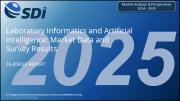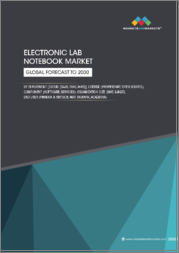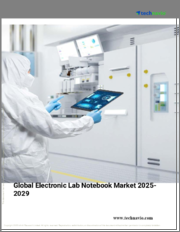
|
시장보고서
상품코드
1726302
미국의 실험실 정보학 시장 : 시장 규모, 점유율, 동향 분석 보고서 - 제품별, 제공 형태별, 컴포넌트별, 최종 용도별, 부문별 예측(2025-2030년)U.S. Laboratory Informatics Market Size, Share & Trends Analysis Report By Product (LIMS, ELN), By Delivery Mode (Cloud-based, On-premise), By Component (Software, Service), By End Use, And Segment Forecasts, 2025 - 2030 |
||||||
미국의 실험실 정보학 시장 성장 및 동향
Grand View Research, Inc.의 최신 보고서에 따르면 미국의 실험실 정보학 시장 규모는 2030년에 16억 2,000만 달러에 이를 전망이며, 2025-2030년 CAGR 3.6%로 성장할 것으로 예측됩니다.
실험실에서 생성되는 데이터 양 증가로 인한 실험실 자동화와 정보 관리 활동에 대한 수요 증가는 시장의 주요 성장 자극 요인 중 하나입니다. 코로나19 팬데믹 관리는 전 세계에서 중요한 과제가 되고 있습니다. 임상실험실은 코로나19 검사 샘플의 급속한 유입 관리에 어려움을 겪고 있으며, 나아가 정확한 검사를 제공하는 능력에 영향을 미치고 있습니다.
임상검사정보관리시스템(LIMS)과 같은 자동화 솔루션의 도입은 대량의 샘플의 효율적인 검사를 촉진함으로써 임상실험실에 대한 이 스트레스를 경감할 것으로 예측됩니다. 실험실은, 헬스케어 산업에서 연구 및 제조 기업 쌍방에 있어서 중요합니다. 이러한 실험실에서는 대량의 데이터가 생성되지만 수작업으로 취득, 수집, 저장 및 분석하는 것은 불가능합니다. 이 때문에, 특히 생명과학 부문과 같은 규제 환경에서는, 데이터 관리 프로세스나 종래형 문서화 요건에 넘을 수 없는 장해가 발생하고 있습니다.
대부분의 실험실에서는 수동 및 자동화된 방법을 결합하여 정보를 관리하고 통합되지 않은 독립형 데이터 처리 시스템을 사용하여 정보를 처리합니다. 실험실에서 독립계 시스템의 사용은 정보 관리 시스템 간의 적시 데이터 전송을 방해하고 예상치 못한 지연과 추가 비용으로 이어집니다. 게다가 수작업에 의한 전송 방법은 에러나 로스의 가능성을 높여 QA 관리의 추가나 수작업에 의한 전기 스텝의 많고 적음으로 이어져 효율의 저하나 스루풋 시간의 장기화를 초래합니다. 원시 데이터에서 재사용 가능한 지식으로의 원활한 정보 흐름은 다양한 인포매틱스 시스템의 조합에 의해 관리됩니다.
실험실에서 이러한 정보 시스템의 도입은 환경(발견, 개발, 제조 등)과 과학 영역(생물학, 화학 등)에 크게 의존합니다. 신약 개발에 있어서 정보학 시스템의 용도는 임상이나 제조 영역에서의 사용 방법과는 다릅니다. 실험실 정보학의 전체적인 초점은 페이퍼리스 정보 관리, 규제 준수, 정보 품질, 인건비에 관한 효율 개선입니다. 전술한 장점은 예측 기간 동안 시장을 확대할 것으로 예상됩니다.
미국 실험실 정보학 시장 보고서 하이라이트
- 아래의 그래프는 시장의 집중도, 산업의 특징, 시장 참가 기업의 관계를 나타내고 있습니다. X축은 산업의 집중도를 나타내며 낮은 것부터 높은 것까지 다양합니다.
- 제품별로는 LIMS 부문이 2024년에 48% 이상의 최대 수익 점유율을 차지했으며, 예측 기간 중에 유리한 성장이 예상됩니다.
- 제공 형태별로는 웹 기반의 솔루션 부문이 2024년에 45% 이상의 최대 수익 점유율을 차지했으며, 예측 기간 중에 가장 급성장할 것으로 예측되고 있습니다.
- 컴포넌트별로 시장은 서비스 및 소프트웨어로 구분됩니다. 2024년에는 시스템 구현, 검증, 통합, 지속적 유지보수에 대한 수요 증가로 서비스 부문이 시장을 독점했습니다.
- 최종 용도별로는 생명과학 부문이 2024년에 28% 이상을 차지했습니다. 창약, 개별화 의료, 생물제제 개발에 대한 주목의 고조에 따라 효율적인 관리를 필요로 하는 대량의 복잡한 데이터가 생성됩니다.
- CRO는 예측 기간 동안 가장 빠른 성장률로 성장할 것으로 예측됩니다. 효율적인 데이터 관리와 규제 컴플라이언스 요구가 CRO를 ELN, LIMS, SDMS 등 선진 실험실 정보학 솔루션 도입으로 몰고 있습니다.
목차
제1장 조사 방법 및 범위
제2장 주요 요약
제3장 미국 실험실 정보학 시장의 변수, 동향 및 범위
- 시장 계통의 전망
- 모 시장 전망
- 관련 및 보조적인 시장 전망
- 시장 역학
- 시장 성장 촉진요인 분석
- 시장 성장 억제요인 분석
- 산업 기회 분석
- 산업의 과제 분석
- 이용 사례
- 미국의 실험실 정보학 시장 분석 도구
- 산업 분석-Porter's Five Forces 분석
- PESTEL 분석
제4장 미국의 실험실 정보학 시장 : 제품별 추정 및 동향 분석
- 제품별 부문 대시보드
- 제품별 시장 점유율 변동 분석(2024년, 2030년)
- 제품별 시장 규모, 예측 및 동향 분석(2018-2030년)
- 검사 정보 관리 시스템(LIMS)
- 전자연구노트(ELN)(ELN)
- 과학 데이터 관리 시스템(SDMS)
- 실험실 실행 시스템(LES)
- 전자 데이터 수집(EDC) 및 임상 데이터 관리 시스템(CDMS)
- 크로마토그래피 데이터 시스템(CDS)
- 엔터프라이즈 컨텐츠 관리(ECM)
제5장 미국의 실험실 정보학 시장 : 제공 형태별 추정 및 동향 분석
- 부문 대시보드
- 제공 형태별 부문 대시보드
- 제공 형태별 시장 점유율 변동 분석(2024년, 2030년)
- 제공 형태별 시장 규모, 예측 및 동향 분석(2018-2030년)
- 온프레미스
- 웹 호스트
- 클라우드
제6장 미국의 실험실 정보학 시장 : 컴포넌트별 추정 및 동향 분석
- 컴포넌트별 부문 대시보드
- 컴포넌트별 시장 점유율 변동 분석(2024년, 2030년)
- 컴포넌트별 시장 규모, 예측 및 동향 분석(2018-2030년)
- 소프트웨어
- 서비스
제7장 미국의 실험실 정보학 시장 : 최종 용도별 추정 및 동향 분석
- 최종 용도별 부문 대시보드
- 최종 용도별 시장 점유율 변동 분석(2024년, 2030년)
- 최종 용도별 시장 규모, 예측 및 동향 분석(2018-2030년)
- 생명과학기업
- CRO
- 석유화학정제소와 석유 및 가스산업
- 화학 산업
- 음식 및 농업
- 환경 검사 실험실
- 기타
제8장 경쟁 구도
- 기업 및 경쟁의 분류
- 전략 매핑
- 기업 시장 포지셔닝 분석(2024년)
- 기업 프로파일 및 상장 기업
- Thermo Fisher Scientific Inc.
- LabWare
- Core Informatics.
- Abbott Laboratories
- LabVantage Solutions, Inc.
- LabLynx, Inc.
- PerkinElmer, Inc.
- Waters
- Agilent Technologies
- IDBS
U.S. Laboratory Informatics Market Growth & Trends:
The U.S. laboratory informatics market size is expected to reach USD 1.62 billion in 2030 and is expected to grow at a CAGR of 3.6% from 2025 to 2030, according to a new report by Grand View Research, Inc. The rising demand for lab automation and information management activities owing to the increasing amount of data generated by research laboratories is one of the primary growth stimulants for the market. The COVID-19 pandemic management has become the key challenge across the globe. Clinical laboratories are struggling to manage the rapid influx of COVID-19 testing samples, which, in turn, is affecting their ability to offer precise testing.
The implementation of automated solutions, such as Laboratory Information Management Systems (LIMS), is anticipated to relieve this stress on clinical laboratories by encouraging efficient testing of voluminous samples. Laboratories are important to both research and manufacturing companies in the healthcare industry. A large amount of data is generated in these labs, which is impossible to capture, collect, store, and analyze manually. This is creating insurmountable obstacles for data management processes and conventional documentation requirements, especially in regulated environments, such as the life sciences sector.
Most laboratories manage information by combining manual & automatic methods and process it by using independent non-integrated data-processing systems. The use of isolated systems in laboratories hamper timely data transfer across information management systems, leading to unexpected delays and additional costs. In addition, manual transfer methods increase the likelihood of errors/loss, leading to added QA controls and a high number of manual transcription steps, which result in decreased efficiency and longer throughput time. The seamless flow of information from raw data to reusable knowledge is managed by a combination of various informatics systems.
In a laboratory, the deployment of these informatics systems is highly dependent on the environment (such as discovery, development, or manufacturing) and scientific domain (such as biology, chemistry, among others). The application of an informatics system in drug discovery is different from how it is used in clinical and manufacturing domains. The overall focus of laboratory informatics is efficiency improvement with respect to paperless information management, regulatory compliance, information quality, and labor cost. The aforementioned benefits are expected to augment the market over the forecast period.
U.S. Laboratory Informatics Market Report Highlights:
- The chart below illustrates the relationship between market concentration, industry characteristics, and industry participants. The x-axis represents the level of industry concentration, ranging from low to high
- Based on products, the LIMS segment accounted for the largest revenue share of more than 48% in 2024 and is expected to witness lucrative growth over the forecast period
- Based on delivery modes, the web-based solutions segment accounted for the largest revenue share of over 45% in 2024 and is projected to grow fastest over the forecast period
- Based on components, the market has been further segmented into services and software. The services segment dominated the market in 2024, driven by the rising demand for system implementation, validation, integration, and ongoing maintenance
- Based on end use, the life sciences segment accounted for more than 28% in 2024. The increasing focus on drug discovery, personalized medicine, and biologics development generates large volumes of complex data requiring efficient management
- CROs is anticipated to grow at the fastest growth rate over the forecast year. The demand for efficient data management and regulatory compliance drives CROs to adopt advanced laboratory informatics solutions, such as ELN, LIMS, and SDMS
Table of Contents
Chapter 1. Methodology and Scope
- 1.1. Market Segmentation & Scope
- 1.2. Market Definitions
- 1.2.1. Product Segment
- 1.2.2. Products
- 1.2.3. Delivery Mode
- 1.2.4. Component
- 1.2.5. End Use
- 1.3. Information analysis
- 1.3.1. Market formulation & data visualization
- 1.4. Data validation & publishing
- 1.5. Information Procurement
- 1.5.1. Primary Research
- 1.6. Information or Data Analysis
- 1.7. Market Formulation & Validation
- 1.8. Market Model
- 1.8.1. Commodity Flow Analysis
- 1.9. Total Market: CAGR Calculation
- 1.10. Objectives
Chapter 2. Executive Summary
- 2.1. Market Outlook
- 2.2. Segment Snapshot
- 2.3. Competitive Insights Landscape
Chapter 3. U.S. Laboratory Informatics Market Variables, Trends & Scope
- 3.1. Market Lineage Outlook
- 3.1.1. Parent market outlook
- 3.1.2. Related/ancillary market outlook.
- 3.2. Market Dynamics
- 3.2.1. Market driver analysis
- 3.2.1.1. Growing demand for laboratory automation
- 3.2.1.2. Surging demand for scientific data integration solutions among end-use industries, including life sciences, Contract Research Organizations (CROs), food & beverage, and chemicals
- 3.2.1.3. Rising adoption of Laboratory Information Management Systems (LIMS) among independent and hospital-based labs
- 3.2.2. Market restraint analysis
- 3.2.2.1. High implementation costs
- 3.2.2.2. Regulatory compliance challenges
- 3.2.2.3. Growing cybersecurity and privacy concerns
- 3.2.3. Industry Opportunity Analysis
- 3.2.4. Industry Challenge Analysis
- 3.2.5. Case Studies
- 3.2.1. Market driver analysis
- 3.3. U.S. Laboratory Informatics Market Analysis Tools
- 3.3.1. Industry Analysis - Porter's
- 3.3.1.1. Supplier power
- 3.3.1.2. Buyer power
- 3.3.1.3. Substitution threat
- 3.3.1.4. Threat of new entrant
- 3.3.1.5. Competitive rivalry
- 3.3.2. PESTEL Analysis
- 3.3.2.1. Political landscape
- 3.3.2.2. Technological landscape
- 3.3.2.3. Economic landscape
- 3.3.2.4. Environmental Landscape
- 3.3.2.5. Legal Landscape
- 3.3.2.6. Social Landscape
- 3.3.1. Industry Analysis - Porter's
Chapter 4. U.S. Laboratory Informatics Market: Products Estimates & Trend Analysis
- 4.1. Products Segment Dashboard
- 4.2. Products Market Share Movement Analysis, 2024 & 2030
- 4.3. Market Size & Forecasts and Trend Analysis, by Products, 2018 to 2030 (USD Million)
- 4.3.1. Laboratory Information Management Systems (LIMS)
- 4.3.1.1. Laboratory Information Management Systems (LIMS) market, 2018 - 2030 (USD Million)
- 4.3.2. Electronic Lab Notebooks (ELN)
- 4.3.2.1. Electronic Lab Notebooks (ELN) market, 2018 - 2030 (USD Million)
- 4.3.3. Scientific Data Management Systems (SDMS)
- 4.3.3.1. Scientific Data Management Systems (SDMS) market, 2018 - 2030 (USD Million)
- 4.3.4. Laboratory Execution Systems (LES)
- 4.3.4.1. Laboratory Execution Systems (LES) market, 2018 - 2030 (USD Million)
- 4.3.5. Electronic Data Capture (EDC) & Clinical Data Management Systems (CDMS)
- 4.3.5.1. Electronic Data Capture (EDC) & Clinical Data Management Systems (CDMS) market, 2018 - 2030 (USD Million)
- 4.3.6. Chromatography Data Systems (CDS)
- 4.3.6.1. Chromatography Data Systems (CDS) market, 2018 - 2030 (USD Million)
- 4.3.7. Enterprise Content Management (ECM)
- 4.3.7.1. Enterprise Content Management (ECM) market, 2018 - 2030 (USD Million)
- 4.3.1. Laboratory Information Management Systems (LIMS)
Chapter 5. U.S. Laboratory Informatics Market: Delivery Mode Estimates & Trend Analysis
- 5.1. Segment Dashboard
- 5.2. Delivery Mode Segment Dashboard
- 5.3. Delivery Mode Market Share Movement Analysis, 2024 & 2030
- 5.4. Market Size & Forecasts and Trend Analysis, by Delivery Mode, 2018 to 2030 (USD Million)
- 5.4.1. On-premise
- 5.4.1.1. On-premise market, 2018 - 2030 (USD Million)
- 5.4.2. Web-hosted
- 5.4.2.1. Web-hosted market, 2018 - 2030 (USD Million)
- 5.4.3. Cloud-based
- 5.4.3.1. Cloud-based market, 2018 - 2030 (USD Million)
- 5.4.1. On-premise
Chapter 6. U.S. Laboratory Informatics Market: Component Estimates & Trend Analysis
- 6.1. Component Segment Dashboard
- 6.2. Component Market Share Movement Analysis, 2024 & 2030
- 6.3. Market Size & Forecasts and Trend Analysis, by Component, 2018 to 2030 (USD Million)
- 6.3.1. Software
- 6.3.1.1. Software market, 2018 - 2030 (USD Million)
- 6.3.2. Services
- 6.3.2.1. Services market, 2018 - 2030 (USD Million)
- 6.3.1. Software
Chapter 7. U.S. Laboratory Informatics Systems Market: End Use Estimates & Trend Analysis
- 7.1. End Use Segment Dashboard
- 7.2. End Use Market Share Movement Analysis, 2024 & 2030
- 7.3. Market Size & Forecasts and Trend Analysis, by End Use, 2018 to 2030 (USD Million)
- 7.3.1. Life Science Companies
- 7.3.1.1. Life Science Companies market, 2018 - 2030 (USD Million)
- 7.3.1.2. Pharmaceutical and Biotechnology Companies
- 7.3.1.2.1. Pharmaceutical and Biotechnology Companies market, 2018 - 2030 (USD Million)
- 7.3.1.3. Biobanks/Biorepositories
- 7.3.1.3.1. Biobanks/Biorepositories market, 2018 - 2030 (USD Million)
- 7.3.1.4. Contract Services Organizations
- 7.3.1.4.1. Contract Services Organizations market, 2018 - 2030 (USD Million)
- 7.3.1.5. Academic Research Institutes
- 7.3.1.5.1. Academic Research Institutes market, 2018 - 2030 (USD Million)
- 7.3.2. CROs
- 7.3.2.1. CROs market, 2018 - 2030 (USD Million)
- 7.3.3. Petrochemical Refineries & Oil and Gas Industry
- 7.3.3.1. Petrochemical Refineries & Oil and Gas Industry market, 2018 - 2030 (USD Million)
- 7.3.4. Chemical Industry
- 7.3.4.1. Chemical Industry market, 2018 - 2030 (USD Million)
- 7.3.5. Food and Beverages and Agriculture
- 7.3.5.1. Food and Beverages and Agriculture market, 2018 - 2030 (USD Million)
- 7.3.6. Environmental Testing Labs
- 7.3.6.1. Environmental Testing Labs market, 2018 - 2030 (USD Million)
- 7.3.7. Other Industries
- 7.3.7.1. Other Industries market, 2018 - 2030 (USD Million)
- 7.3.1. Life Science Companies
Chapter 8. Competitive Landscape
- 8.1. Company/Competition Categorization
- 8.2. Strategy Mapping
- 8.3. Company Market Position Analysis, 2024
- 8.4. Company Profiles/Listing
- 8.4.1. Thermo Fisher Scientific Inc.
- 8.4.1.1. Company overview
- 8.4.1.2. Financial performance
- 8.4.1.3. Product benchmarking
- 8.4.1.4. Strategic initiatives
- 8.4.2. LabWare
- 8.4.2.1. Company overview
- 8.4.2.2. Financial performance
- 8.4.2.3. Product benchmarking
- 8.4.2.4. Strategic initiatives
- 8.4.3. Core Informatics.
- 8.4.3.1. Company overview
- 8.4.3.2. Financial performance
- 8.4.3.3. Product benchmarking
- 8.4.3.4. Strategic initiatives
- 8.4.4. Abbott Laboratories
- 8.4.4.1. Company overview
- 8.4.4.2. Financial performance
- 8.4.4.3. Product benchmarking
- 8.4.4.4. Strategic initiatives
- 8.4.5. LabVantage Solutions, Inc.
- 8.4.5.1. Company overview
- 8.4.5.2. Financial performance
- 8.4.5.3. Product benchmarking
- 8.4.5.4. Strategic initiatives
- 8.4.6. LabLynx, Inc.
- 8.4.6.1. Company overview
- 8.4.6.2. Financial performance
- 8.4.6.3. Product benchmarking
- 8.4.6.4. Strategic initiatives
- 8.4.7. PerkinElmer, Inc.
- 8.4.7.1. Company overview
- 8.4.7.2. Financial performance
- 8.4.7.3. Product benchmarking
- 8.4.7.4. Strategic initiatives
- 8.4.8. Waters
- 8.4.8.1. Company overview
- 8.4.8.2. Financial performance
- 8.4.8.3. Product benchmarking
- 8.4.8.4. Strategic initiatives
- 8.4.9. Agilent Technologies
- 8.4.9.1. Company overview
- 8.4.9.2. Financial performance
- 8.4.9.3. Product benchmarking
- 8.4.9.4. Strategic initiatives
- 8.4.10. IDBS
- 8.4.10.1. Company overview
- 8.4.10.2. Financial performance
- 8.4.10.3. Product benchmarking
- 8.4.10.4. Strategic initiatives
- 8.4.1. Thermo Fisher Scientific Inc.
(주말 및 공휴일 제외)


















